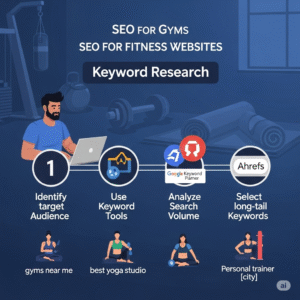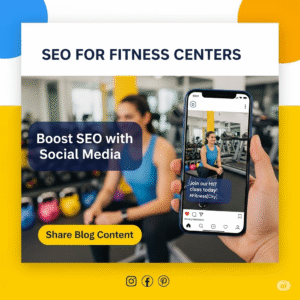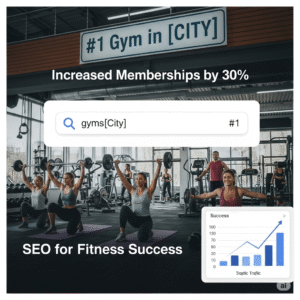Home > Services >Understanding SEO for Gyms
SEO for Gyms
SEO for Gyms can make your fitness center the first choice when someone searches “gyms near me” on Google. According to Statista, 60% of gym users research online before joining, meaning your online presence is your most powerful membership driver. With over 6 billion websites online, standing out in the fitness industry requires smart SEO for Gyms to capture local clients searching for your services. This blog is your step-by-step guide to mastering SEO for Fitness Centers, covering everything from keyword research and content marketing to technical SEO, social media, influencer marketing, and digital PR. Whether you’re a beginner gym owner or an advanced marketer, you’ll find actionable strategies to boost your gym’s visibility and memberships.
Why SEO Matters for Gyms and Fitness Centers
SEO for Fitness Centers is the key to unlocking more memberships and skyrocketing your online visibility. In an industry where the U.S. fitness market generates $25.8 billion annually, with 70% of gym leads coming from online searches (Statista), showing up on Google’s first page is non-negotiable. Unlike traditional marketing like flyers or billboards, which can cost thousands and reach a limited audience, SEO drives targeted, organic traffic to your website—people actively searching for your services. Reports show that users typically click only the top Google results, making SEO for Fitness Centers crucial for driving organic traffic and reducing reliance on costly ads. For example, a flyer might reach 100 people, but a well-optimized website can attract thousands of local fitness enthusiasts monthly.
SEO is like a workout plan: consistent effort yields long-term results. It’s about making your gym discoverable when potential members search for terms like “gym in [city]” or “best personal trainer near me.” A Reddit thread in r/smallbusiness highlighted a gym owner’s struggle: “I spent $2,000 on flyers, but my website barely gets 50 visits a month.” SEO fixes this by ensuring your website ranks high, driving quality leads without the recurring costs of paid ads.
Keyword Research for Fitness Websites
SEO for Fitness Websites begins with knowing your audience. Understand who’s searching for your services—busy professionals, beginners, or local fitness buffs—by creating a buyer persona (a fictional profile of your ideal client, including age, gender, and goals). Tools like SEMrush’s one2target can reveal audience interests, while analyzing competitors’ websites shows which keywords attract similar clients. This ensures your SEO for Fitness Websites targets the right people. Keyword research, the foundation of SEO, involves using tools like Google Keyword Planner, SEMrush, or Ahrefs to uncover search terms.
Beginner tip: Target local keywords like “gyms in [location]” or “fitness classes [city].” These are less competitive and attract nearby clients. For example, “gyms in Austin” is easier to rank for than “gyms.”
Advanced strategy: Focus on long-tail keywords like “best personal trainer in Austin for weight loss” to capture specific, high-intent audiences. SEMrush reports that low-competition keywords can boost traffic by 30%.
For instance, “fitness website” is a broad, high-competition short-tail keyword, while “fitness exercises for obese people in [city]” is a niche, low-competition long-tail keyword. Check Google’s “Related searches” section for ideas like “easy exercises for beginners,” which reflect what your audience is searching for. A gym owner’s blog on Medium shared their success: “After targeting ‘yoga classes Denver’ with SEMrush, my site’s traffic doubled in three months.”
Keyword Research Checklist:
- Use Google Keyword Planner for free insights.
- Try SEMrush or Ahrefs for competitor analysis.
- Target 5–10 local and long-tail keywords initially.
- Monitor performance with Google Search Console.
Content Marketing for Gyms
SEO for Gyms thrives on valuable content that engages users and builds authority. Blog posts like “5 Home Workouts for Busy Professionals” or “Nutrition Tips for Muscle Gain” can rank for fitness keywords and attract potential members. Content establishes your gym as a trusted resource, encouraging visitors to explore your services. HubSpot notes that content marketing generates three times more leads than paid ads, making it a cost-effective way to grow.
Create content that answers common fitness questions, like “How to start weightlifting” or “Best cardio for fat loss.” A Reddit thread in r/Entrepreneur shared a gym owner’s success: “I posted weekly workout tips on my blog, and memberships jumped 20% in six months.” Mix formats—blogs, videos, infographics—to keep users engaged. For example, a video on “Proper Deadlift Form” can rank on YouTube and drive traffic to your site. For SEO for Gyms, ensure your content is original—Google prioritizes human-written blogs over AI-generated text, which can hurt rankings. Include strong calls-to-action like “Book a Free Session” or “Join Our Classes” to guide visitors toward signing up. Respond to comments on your blog to build engagement and trust.
Content Calendar Template:
| Topic | Keyword | Format | |
| 1 | Home Workouts | “home workouts [city]” | Blog |
| 2 | Nutrition Guide | “nutrition for fitness” | Infographic |
| 3 | Gym Class Guide | “fitness classes [city]” | Video |
| 4 | Success Story | “weight loss success” | Blog |
Technical SEO for Fitness Websites
SEO for Fitness Websites isn’t just about content—it’s about performance. Technical SEO ensures your site is fast, mobile-friendly, and easy for search engines to crawl. A slow website is like a crowded gym: it frustrates users and makes them leave. Google’s PageSpeed Insights shows that pages loading in under 2 seconds have 15% higher conversion rates. Use tools like Google’s Mobile-Friendly Test to ensure your site works seamlessly on smartphones, as over 50% of searches are mobile (Ink Digital).
Beginner tip: Optimize images (compress without losing quality) and use a content delivery network (CDN) for faster load times. Advanced tactic: Implement schema markup, like event schema for gym classes, to enhance search result snippets. For example, a yoga studio used schema markup to display class schedules directly in Google results, boosting clicks by 10%. Optimize your Google Business Profile (GBP) with accurate NAP (Name, Address, Phone) details and regular updates, as GBP drives local visibility. For SEO for Fitness Websites, ensure your site is easy to navigate with clear sections for classes, trainers, and memberships. Use A/B testing to experiment with layouts or CTAs, tracking results in Google Analytics. Regularly check for broken links using tools like Ahrefs, as they can harm your rankings.
Technical SEO Checklist:
- Test site speed with Google PageSpeed Insights.
- Ensure mobile-friendliness with Google’s Mobile-Friendly Test.
- Create an XML sitemap for better crawling.
- Add schema markup for classes or events.
On-Page SEO for Fitness Websites
SEO for Fitness Websites also involves on-page optimization, like crafting keyword-rich title tags and meta descriptions. For example, if you run a gym in Miami, use a title like “Best Affordable Gym in Miami” and a meta description that invites clicks, such as “Join our top-rated Miami gym for affordable fitness classes.” Use header tags (H2, H3) to structure content and include keywords naturally, like “Top Workouts for Beginners” in a blog. Optimize images with descriptive alt text, like “Miami gym yoga class,” to boost visibility.
Technical SEO Checklist:
- Test site speed with Google PageSpeed Insights.
- Ensure mobile-friendliness with Google’s Mobile-Friendly Test.
- Create an XML sitemap for better crawling.
- Add schema markup for classes or events.
Off-Page SEO and Digital PR
SEO for Fitness extends beyond your website with off-page SEO and digital PR. Off-page SEO includes earning backlinks from reputable sites, like guest posts on fitness blogs or mentions in local news. Moz states that high-quality backlinks can improve rankings by 20%. Digital PR, like a press release about a new gym program or a feature in a local outlet, drives traffic and builds credibility. For example, a gym featured in a local newspaper for a charity fitness event saw a 15% traffic spike.
A Reddit post in r/SEO shared a gym owner’s PR success: “A local news feature on our bootcamp got us 10 backlinks and 50 new leads.” Reach out to fitness bloggers for guest posts or collaborate with local businesses for co-promotions. Pro tip: Use tools like Ahrefs to track backlinks and ensure they come from authoritative sites.
Social Media for Fitness SEO
SEO for Fitness Centers gets a boost from social media, which drives traffic and indirectly improves rankings through social signals (likes, shares). Sharing blog posts on Instagram, Pinterest, or Facebook can amplify your reach. Sprout Social reports that 80% of gym members use social media to find fitness content, making platforms like Instagram ideal for showcasing workouts or client transformations.
A fitness influencer’s blog noted: “Posting daily Instagram Reels of quick workouts doubled my gym’s website visits.” Beginner tip: Share blog links with engaging captions. Advanced strategy: Use Pinterest for infographics or YouTube for workout tutorials, optimizing with keywords like “fitness classes [city].” A Reddit thread in r/socialmedia emphasized: “Consistent posting on Instagram Stories drove 30% more traffic to my gym’s site.”
Social Media Strategy Table:
| Platform | Content Type | Frequency | Keyword Example |
| Workout Reels | 3x/week | “gym workouts [city]” | |
| Infographics | 2x/week | “fitness tips” | |
| YouTube | Tutorials | 1x/week | “HIIT workout tutorial” |
| Blog Shares | 2x/week | “nutrition guide [city]” |
Influencer Marketing for Gyms
SEO for Gyms gets a massive lift from influencer marketing. Partnering with fitness influencers can drive traffic and earn backlinks when they link to your site. Nielsen reports that influencer marketing delivers 11 times higher ROI than traditional ads. Beginner tip: Collaborate with local micro-influencers (1,000–10,000 followers) who align with your brand. Advanced strategy: Sponsor content with fitness bloggers who can write SEO-optimized posts linking to your site.
A Reddit thread in r/marketing shared a gym’s success: “A local influencer’s Instagram post about our bootcamp brought 20 new members.” For example, a CrossFit gym partnered with a local fitness YouTuber, resulting in a blog post that ranked for “CrossFit [city]” and boosted memberships by 25%. Track campaigns with tools like Google Analytics to measure traffic and conversions.
Local SEO for Fitness Centers
SEO for Fitness Centers hinges on local SEO to attract nearby clients. Google reports that 70% of users search for local businesses online, and optimizing your Google Business Profile (GBP) is critical. Ensure your GBP has accurate NAP details, high-quality photos, and regular updates like class schedules. Encourage clients to leave reviews, as positive ratings boost local rankings. Listing sites like Yelp or Yellow Pages also enhance visibility—ensure consistent NAP across all platforms.
Beginner tip: Add local keywords like “fitness center [city]” to your website and GBP. Advanced tactic: Create location-specific landing pages for each gym branch. A yoga studio in Seattle optimized its GBP with weekly posts and saw a 40% increase in local search visibility.
Emerging Trends in Fitness SEO
SEO for Fitness Websites must adapt to trends like voice search, AI tools, and video SEO. Search Engine Journal notes that voice search accounts for 20% of mobile queries, so optimize for natural phrases like “best gym near me.” AI tools like ChatGPT can generate content ideas, such as blog topics or social media captions. Video SEO, like optimizing YouTube workout tutorials with keywords, is gaining traction. A fitness blog on Medium shared: “Our YouTube channel’s workout videos ranked for ‘home fitness,’ driving 1,000 monthly site visits.”
Trend to Watch: Use schema markup for video content to appear in rich snippets. Tools like AnswerThePublic can identify voice search queries, ensuring your content aligns with how people speak.
Case Studies
- CoreFit Gym, Austin: CoreFit used local SEO and influencer marketing to rank #1 for “gym Austin.” By optimizing its GBP and partnering with a local fitness Instagrammer (10,000 followers), the gym saw a 30% membership increase in six months. A Reddit post in r/Entrepreneur praised their strategy: “Their Instagram Reels and GBP reviews made them impossible to miss.”
- YogaFlow Studio, Seattle: YogaFlow implemented video SEO and content marketing, posting weekly YouTube tutorials optimized for “yoga classes Seattle.” Combined with schema markup for class schedules, they boosted traffic by 25% and added 50 new members in three months.
- PowerLift Fitness, Miami: PowerLift focused on digital PR, securing a feature in a local fitness magazine. The article included backlinks to their site, improving rankings for “personal trainer Miami” and driving a 20% lead increase.
FAQs
How does content marketing improve SEO for gyms?
Content marketing, like blogs or videos on fitness topics, ranks for keywords like “workout tips” and builds authority, signaling to Google that your site is a trusted resource.
What technical SEO factors matter most for fitness websites?
Site speed, mobile-friendliness, XML sitemaps, and schema markup are critical. Fast-loading, mobile-optimized sites improve user experience and rankings.
How can social media boost my gym’s SEO?
Sharing content on platforms like Instagram or YouTube drives traffic and engagement, indirectly boosting SEO through social signals and backlinks.
How do I choose the right fitness influencer?
Look for influencers whose audience matches your target demographic. Local micro-influencers with 1,000–10,000 followers often offer high engagement at lower costs.
What’s the role of digital PR in SEO for fitness centers?
Digital PR, like media features or guest posts, earns high-quality backlinks and increases brand credibility, improving rankings and traffic.
How long does SEO take to show results?
SEO typically takes 3–6 months to show significant results, depending on competition and consistency. Regular content and technical updates accelerate progress.
Key Takeaways
SEO for Gyms is your ticket to dominating local search and attracting more members. Keyword research targets high-intent clients, content builds authority, and technical SEO ensures a smooth user experience. Social media and influencer marketing amplify your reach, while digital PR and local SEO cement your gym as a community staple. Start with these actionable steps:
- Claim and optimize your Google Business Profile.
- Publish one blog post weekly targeting local keywords.
- Test your site’s speed and mobile-friendliness.
- Reach out to a local influencer for a collaboration.
Ready to grow your gym’s online presence? Start with a free Google Business Profile and a blog post today! For advanced strategies, consider tools like Ahrefs or consult an SEO expert to take your fitness center to the top of Google’s results.



